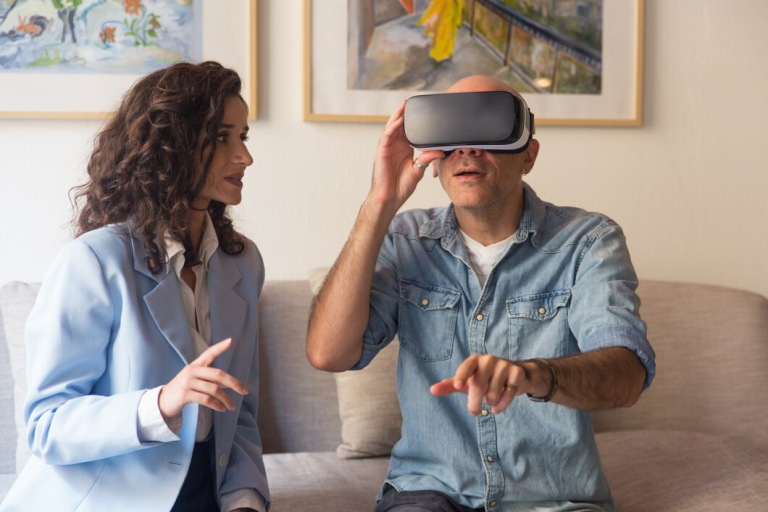The fields of architecture and interior design demand a high level of expertise and creativity. Traditionally, professionals in these industries have relied on a combination of education, experience, and trial and error to develop their skills. However, as technology continues to advance, there’s a new tool that’s changing the way architects and designers learn and refine their craft: Virtual Reality (VR). In this blog post, we’ll explore the role of VR-based training and simulation in architecture and interior design and how it’s revolutionizing professional development.
The Power of Immersive Learning
Virtual Reality offers a unique advantage in education and training—immersive learning. Instead of relying solely on textbooks, lectures, or 2D images, VR enables learners to step into a fully immersive 3D environment. For architects and interior designers, this means having the opportunity to interact with and experience spaces as if they were physically present.
Hands-On Experience: VR-based training allows professionals to gain hands-on experience in a risk-free virtual environment. They can experiment with different design concepts, materials, and layouts, and immediately see the results. This practical experience is invaluable for skill development.
Spatial Understanding: Architecture and interior design are highly spatial disciplines. VR helps learners develop a deep understanding of spatial relationships, proportions, and scale. It allows them to navigate and manipulate virtual spaces, which is crucial for creating functional and aesthetically pleasing designs.
Real-time Feedback: In a virtual environment, learners can receive real-time feedback on their design decisions. This immediate feedback loop accelerates the learning process, enabling professionals to refine their skills rapidly.
VR-Based Training Programs
Several VR-based training programs and platforms have emerged to cater to the specific needs of architects and interior designers:
Design Software Integration: VR can be integrated with popular design software like AutoCAD and Revit. Architects and designers can import their 3D models into VR, allowing them to explore and refine their designs in a more immersive way.
Interactive Design Workshops: Virtual design workshops provide a collaborative environment where professionals can work together on design challenges. These workshops often simulate real-world scenarios, fostering critical thinking and problem-solving skills.
Construction Simulation: VR can also be used to simulate construction processes. This allows architects to gain insight into the practical challenges of building their designs and make adjustments accordingly.
Historical and Cultural Exploration: For interior designers working on historical or culturally significant projects, VR can provide virtual tours of historical buildings and spaces. This helps designers understand the context and history of their projects better.
Sustainable Design Visualization: As sustainability becomes increasingly important, VR can be used to visualize the environmental impact of design choices. Professionals can see how energy-efficient features or sustainable materials affect the overall design.
Advantages of VR-Based Training and Simulation
The adoption of VR-based training and simulation in architecture and interior design offers several advantages:
Accessibility: VR training is accessible from anywhere with the necessary hardware. Professionals can practice and learn without being tied to a physical location.
Cost-Effective: VR-based training can significantly reduce the costs associated with traditional training methods, such as physical mock-ups or site visits.
Realistic Scenarios: VR can replicate real-world scenarios, including challenging design situations or complex construction environments. This prepares professionals for the practical aspects of their work.
Risk Reduction: Mistakes made in a virtual environment have no real-world consequences. This allows learners to take risks, experiment, and learn from their errors without impacting actual projects.
Flexible Learning: Professionals can engage in VR-based training at their own pace, making it suitable for both beginners and experienced practitioners looking to expand their skill sets.
The Future of Professional Development
As VR technology continues to advance, the future of professional development in architecture and interior design looks promising. VR headsets are becoming more affordable and accessible, making it easier for individuals and organizations to incorporate VR-based training into their learning and development programs.
In the coming years, we can expect to see even more sophisticated VR simulations and training modules tailored to the specific needs of architects and designers. These advancements will further enhance the skillsets of professionals and lead to the creation of more innovative and sustainable designs.
In conclusion, VR-based training and simulation are revolutionizing the way architects and interior designers learn, practice, and refine their skills. This immersive and practical approach to professional development not only accelerates learning but also prepares individuals to meet the challenges of designing functional, aesthetically pleasing, and sustainable spaces. As technology continues to evolve, the future of architecture and interior design education is increasingly virtual and promising.
Stay tuned for more updates on the evolving landscape of professional development in these dynamic fields.






